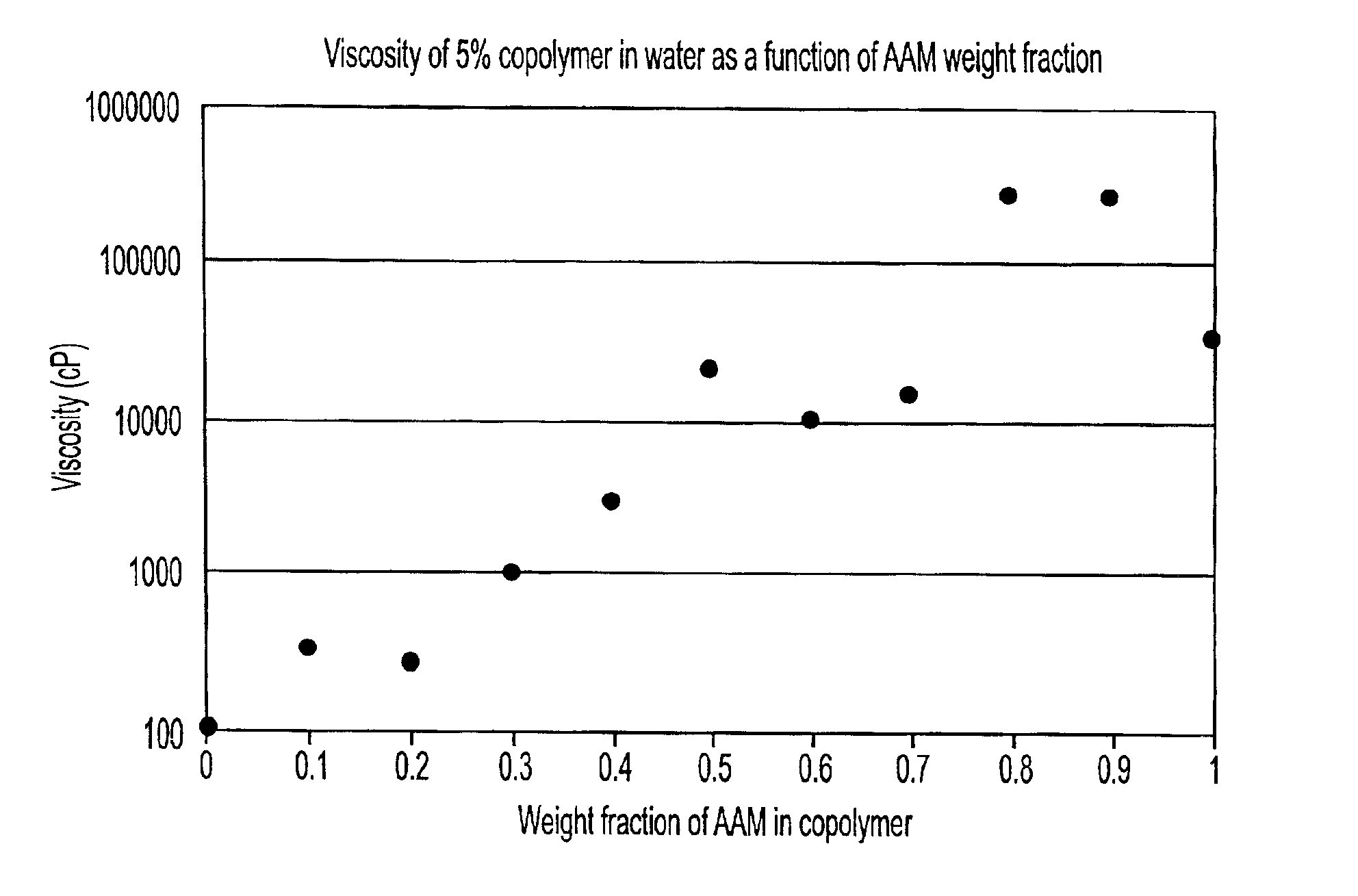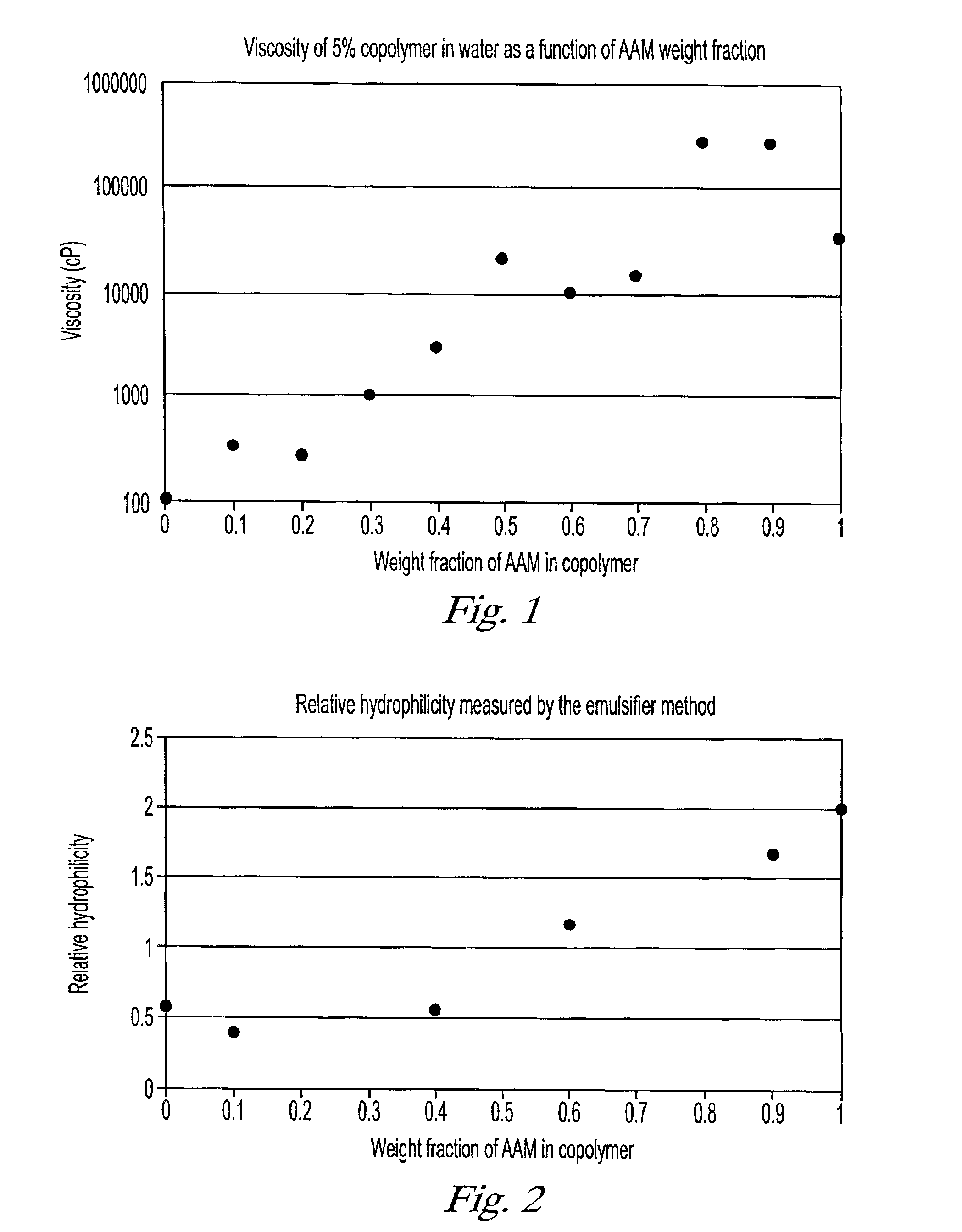Copolymers for capillary gel electrophoresis
a technology of capillary gel and copolymer, which is applied in the direction of fluid pressure measurement, liquid/fluent solid measurement, peptide measurement, etc., can solve the problems of difficult separation, differences in the ability of different sized molecular species to penetrate through the gel matrix, and difficulty in achieving separation in free solutions, etc., to achieve suppressed electroendoosmotic flow, facilitate high separation performance, and optimize electrophoresis performance
- Summary
- Abstract
- Description
- Claims
- Application Information
AI Technical Summary
Benefits of technology
Problems solved by technology
Method used
Image
Examples
example 1
Preparation of 5.0% DMA+0.5% AA Gel Matrix
[0064]1×TBE, 6 M buffer was prepared by dissolving 89 millimoles (mM) of tris(hydroxymethyl)aminomethane(Tris), 2 mM ethylenediaminetetraacetic acid (EDTA), and 6 moles of urea to 1 L of deionized water. 50 mL 1×TBE, 6 M urea buffer was transferred to a 250 mL PYREX bottle. 5.0 g dimethyl acrylamide (DMA) and 0.5 g sodium acrylate (NaAA) were weighed and added to the buffer solution. The final volume was brought up to 100 mL with additional buffer solution. The solution was degassed for 30 minutes in a desiccator chamber with its outlet connected to a diaphragm vacuum pump. After degassing, 25 μL of N,N,N′,N′-tetramethylethylenediamine(TEMED) and 25 μL of 40% (v / v) ammonium persulfate (ASP) were added to the solution. The bottle was capped, and the polymerization was carried out at room temperature for 12 hours.
example 2
Preparation of 3.5% AAm and 1.5% DMA Gel Matrix
[0065]1×TBE, 7 M buffer was prepared by dissolving 89 mM of Tris, 2 mM EDTA, and 7 moles of urea to 1 L of deionized water. 19 mL of 1×TBE, 7 M urea buffer was transferred to a 20 mL scintillation vial. 0.30 g of DMA and 0.70 g acrylamide (AAm) were weighed and added to the buffer solution. Helium was bubbled into the solution at 10 psi for 1 hour. After degassing, 25 μL of TEMED and 25 μL of 40% (v / v) ASP were added to the solution. The bottle was capped, and the polymerization was carried out at room temperature for 12 hours.
example 3
Preparation of 2.5% AAm and 2.5% DMA Gel Matrix
[0066]1×TBE, 7 M buffer was prepared by dissolving 89 mM of Tris, 2 mM EDTA, and 7 moles of urea to 1 L of deionized water. 19 mL of 1×TBE, 7 M urea buffer was transferred to a 20 mL scintillation vial. 0.50 g of DMA and 0.50 g AAm were weighed and added to the buffer solution. Helium was bubbled into the solution at 10 psi for 1 hour. After degassing, 25 μL of TEMED and 25 μL of 40% (v / v) ASP were added to the solution. The bottle was capped, and the polymerization was carried out at room temperature for 12 hours.
PUM
| Property | Measurement | Unit |
|---|---|---|
| lengths | aaaaa | aaaaa |
| inner diameters | aaaaa | aaaaa |
| temperatures | aaaaa | aaaaa |
Abstract
Description
Claims
Application Information
 Login to View More
Login to View More - R&D
- Intellectual Property
- Life Sciences
- Materials
- Tech Scout
- Unparalleled Data Quality
- Higher Quality Content
- 60% Fewer Hallucinations
Browse by: Latest US Patents, China's latest patents, Technical Efficacy Thesaurus, Application Domain, Technology Topic, Popular Technical Reports.
© 2025 PatSnap. All rights reserved.Legal|Privacy policy|Modern Slavery Act Transparency Statement|Sitemap|About US| Contact US: help@patsnap.com



